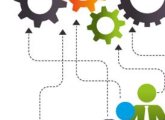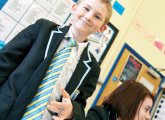Unleash learnersí musical creativity with a little technology and a lot of freedom, says Christopher Woolham
So, your Year 9 students have chosen their options. And while a significant minority have selected music at Key Stage 4, the remainder of the year group have another term left studying a subject they didnít opt for, and motivation is, inevitably, on the slide. What you need is a programme of study that taps into what your class members really enjoy, has a technical twist, and will keep them engaged (and making Unleash learnersí musical creativity with a little technology and a lot of freedom, says Christopher Woolham
TODAY YOU WILL…
Explore a range of sound styles in any music of your choice + experiment with different sound sources in logic pro (or other digital sequencer) + begin to create the sound world for your own track + record your initial ideas, e.g. beats, crazy sounds, vocals, etc
MAIN ACTIVITIES
WEEK BY WEEK…
The ongoing process of being creative with sound is now underway and as the project unfolds, studentsí musical creations will develop along the lines of a piece of GCSE composition coursework; the long-term aim being for each student to end year 9 with a recording of his or her own ëtrackí to take away as a memento of his or her musical development, skills or talent. The teacherís role in the process from week to week becomes that of facilitator, guiding students where necessary in moving their ideas forwards with creative steering and modeling while also supporting technically. A series of miniature skills tutorials can be undertaken throughout the project each week introducing or embedding knowledge of software control and production techniques. (Note: video tutorials can also be accessed by students through Youtube to promote independent learning and problem solving skills). This could incorporate basic recording functions (e.g. recording to a metronome, quantizing, creating new tracks and instrument selection), through to more complex features like editing recordings, punching in and out, mixer controls (e.g. panning, EQ, effects and balancing the mix) or direct recording of real instrument and vocals with sound manipulation through amps, vocoders and effects boxes. Itís easy to source enough skills tutorials to span the whole project and beyond, developing real professional music production skills to motivate and excite the masses while also providing essential training and creative exploration for prospective Year 10 Music GCSE candidates in preparation for composition coursework tasks.
Week to week the modelling process and stimuli response generated in the first week can then be continued, breaking down the different features of progress) despite themselves, right up to the end of term… Resources used for the initial lesson and its subsequent project are as follows:
- An iMac suite running Logic Pro or any other music technology facility suitable for whole or part class use (With smaller music technology setups students without continual access to sequencing software can explore ideas through real instruments and rotate equipment usage to record maintain recording new ideas).
A range of electric-acoustic instruments, as required, with the onus being given to students on the appropriateness of their use.
Break-out space is useful, as with all practical music lessons, to give students the freedom to clarify ideas out-loud (especially vocalists).
- Access to Youtube on a school network.
STARTER ACTIVITY
Instruct students to find Danthology 2012í on YouTube (youtube.com/watch?v=If5MF4wm1 T8). With headphones on, they should open Logic Pro, find one or two sounds that fit with any of the remixes and play along however they like!
After a while, go for a class remix improvisation: playback the Danthology video through classroom speakers. Students remove headphones, choose their sounds and away we go everybody joins in wherever they like with whatever they like.
HOME LEARNING
Two particularly powerful home learning tasks associated with the project and to develop general music composing skills are: + FruityLoops studio, step-time sequencer demo, can be downloaded for free for students to experiment with musical ideas from home without the need for any musical equipment including even a USB controller keyboard. All features of the software can be manipulated through mouse click alone and therefore just require a PC or Mac.
With the plethora of Youtube videos and the self-made tutorial, students can access specific information and instruction to complete set learning tasks to embed skills development with software manipulation and technical learning.
INFO BAR
The nature of the project caters to students of all starting points and potential for progression. the key elements that should be underpinned and driven with more able students are: higher-level operation and skills development in production techniques; and more independently creative musical ideas with modeling just used as a starting point from which to deviate significantly ñ complexity of musical textures, structures and sound manipulation should be encouraged at all points. with some students this can often become an artistic conversation where as a teacher i almost become co-producer, bouncing ideas between students.
About the expert
Christopher Woolham is currently deputy director of performing & expressive arts at Stretford High School, Manchester. Since beginning teaching he has specialised in developing music in challenging urban schools, believing passionately in the real differences the arts can make to childrenís lives in this setting. He has established a music programme in his current school that provides free instrumental tuition to 300 students, enters 200 students annually for music grades and has a mentoring programme to develop talent and place students for either further academic or career progression in the music world.
SUMMARY
Finally with the ongoing process of week-to-week development of studentsí musical ideas, skills development and ultimately their completed tracks, you can use a series of assessment and feedback tools to maintain forward direction:
- All students can place a copy of their tracks in a shared network folder for other students to access to listen and learn from and review for peer assessment and feedback. Sharing created music is a particularly high impact learning activity, with students becoming inspired, motivated and stimulated by hearing and reviewing othersí work. The review process when undertaken as a piece of peer assessment should also be done against formal assessment criteria, for which I use the GCSE Music composition mark scheme; equating marks to National Curriculum levels.
Socrative, an iPad App with its associated website, is a transformational formative assessment tool that can be run through either a computer suite or through studentsí personal internet connected mobile devices (phones, iPad, Android tablet, etc.) Logging into socrative.com, students sign into the teacherís room number and submit their answer to either prewritten questions or as a response to the teacherís verbal questioning. With all answers appearing on the teacherís iPad App in real time, the range and accuracy of knowledge can be assessed across the class at a snapshot and any incorrect learning addressed on the spot. With Socrative quizzes, class reports can be generated to compile an ongoing record of studentsí knowledge and when linked to AlwaysPrepped.com can aggregate all quiz/ test outcomes to provide a powerful tool for data driven learning at a classroom level. AlwaysPrepped is also linked with both Khan Academy (free online tutorials provider) and Engrade (free web-based grade book) allowing the teacher to integrate online learning assignments, tracking of student progress and to keep an accurate picture of a studentís individual knowledge base.









